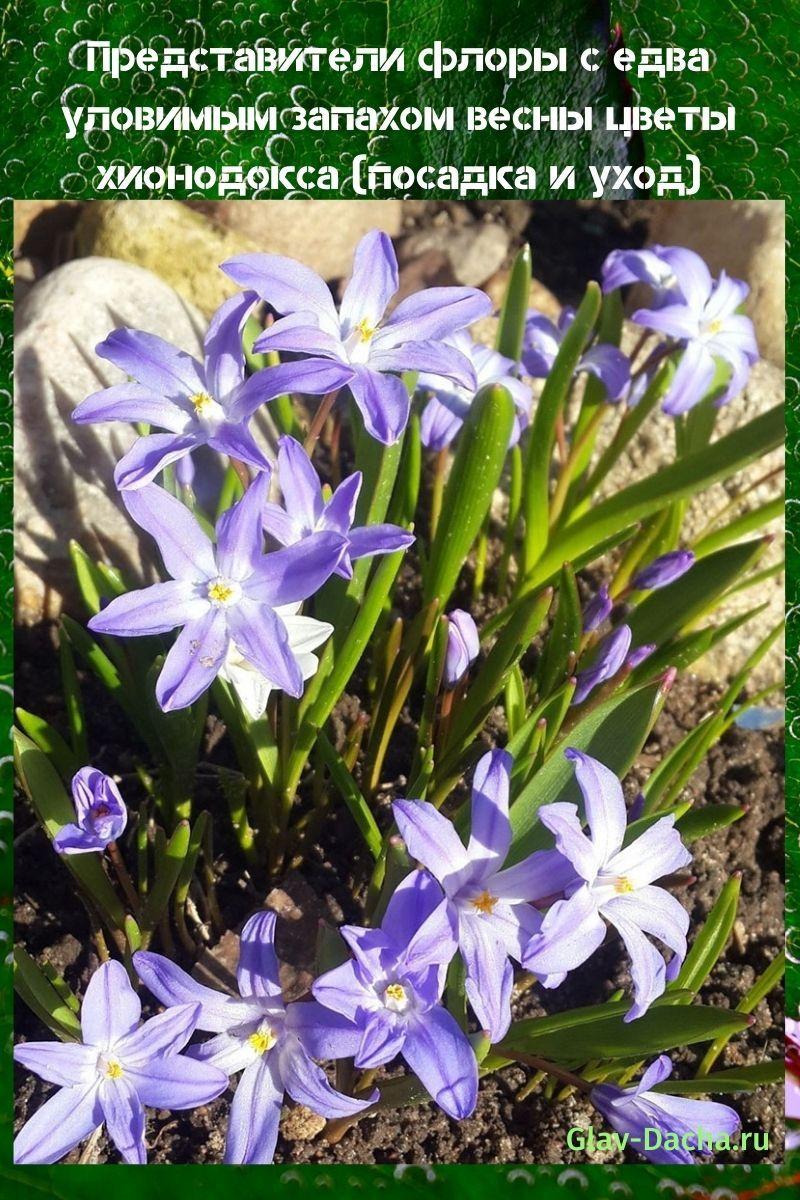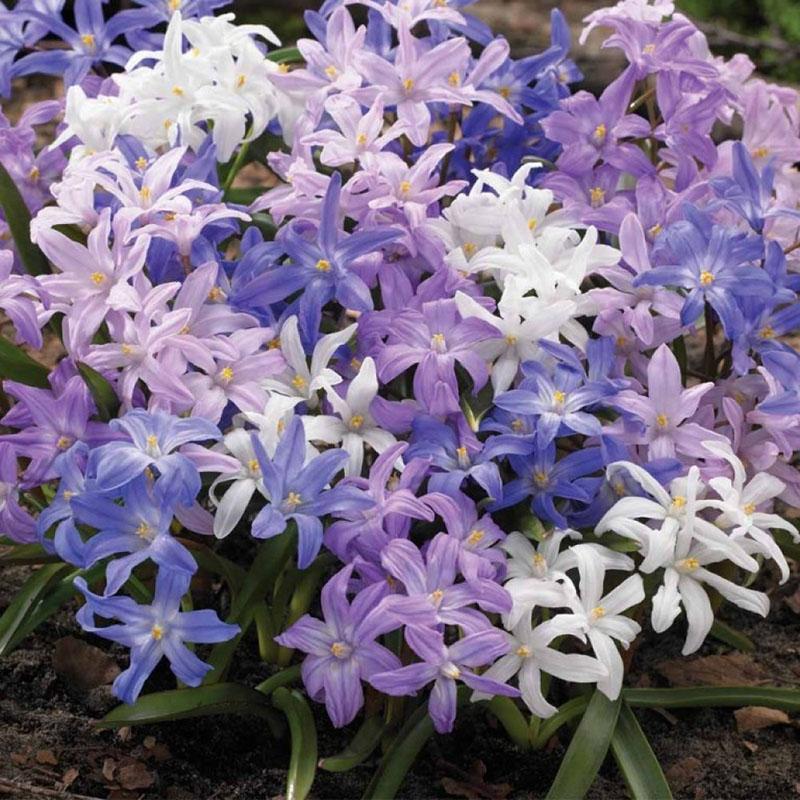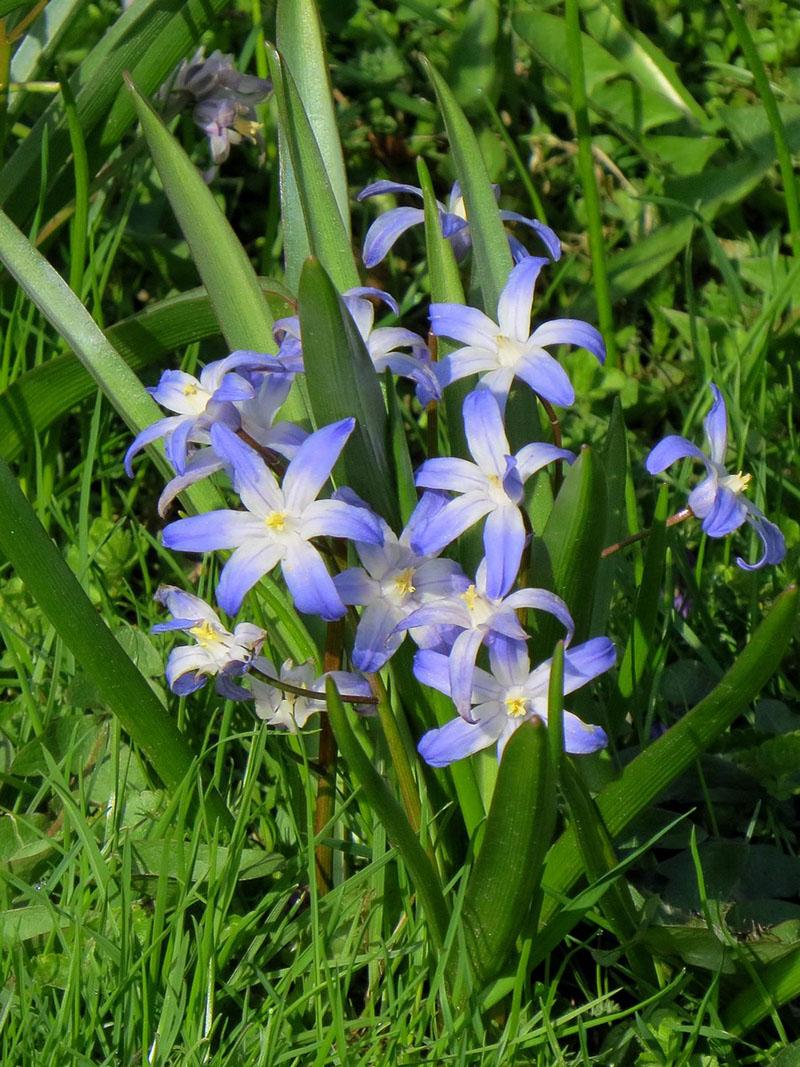Representatives of the flora with a subtle scent of spring Chionodox flowers (planting and care)
 Timid, delicate primroses always attract special attention with their bright inflorescences among the snowdrifts that have just begun to melt. Chionodox flowers also belong to this category, planting and caring for which begins when the ground is still covered with snow. The plant blooms with the onset of April warm days, and the aerial part dies off in June. This feature of primroses allows you to enjoy their beauty against the background of spring snows.
Timid, delicate primroses always attract special attention with their bright inflorescences among the snowdrifts that have just begun to melt. Chionodox flowers also belong to this category, planting and caring for which begins when the ground is still covered with snow. The plant blooms with the onset of April warm days, and the aerial part dies off in June. This feature of primroses allows you to enjoy their beauty against the background of spring snows.
Varieties of Chionodox

In total, there are 6 varieties of Chionodox, gardeners grow 3 of them:
- Chionodox Forbes (Tmoluza). Grows wild in Turkey. Forms a loose raceme consisting of 14-15 whitish or pinkish flowers. It grows up to 35 cm. A distinctive feature is the absence of seeds, but new bulbs appear with each flowering. Cultivated varieties - Lucilia Alba with white flowers, Blue Giant with blue inflorescences, Pink Jite with pink flowers.

- Chionodoxa Sardinian. It grows in Asia Minor. On a loose brush, it grows up to 10 bright blue flowers up to 2 cm in diameter. The main cultivars of the Sardinian Chionodoxa are the dwarf, whitish and Chionodoxa of Mrs. Lok.

- Chionodoxa Lucilia (Chionodoxa luciliae), she is giant. Occurs wildly in the mountains of Asia Minor. Originally and on the Mediterranean islands. It is characterized by leaves in the form of a groove, and inflorescences of white, pinkish and bluish color with a whitish pharynx, collected in inflorescences of 10 pieces. Among the cultivated varieties of this plant, Rose (Pink) Queen is distinguished with flowers of a beautiful rich pink shade and a giant white, distinguished by large (up to 4 cm in diameter) white flowers.

Blue Giant is also popular. Variety with narrow bright green leaves and blue bell-shaped flowers. And Chionodox Violet Beauty. It is a herbaceous perennial with dense, dark green linear leaf blades and purple bell-shaped flowers.
Surprisingly, the Chionodoxes feature is easy to interbreed. The result is the most unusual hybrid plants with incredible coloration.
Reproduction
 Chionodoxa can reproduce by self-seeding, seeds, bulbs. But it should be borne in mind that after 4-5 years of growth in one place, the plants run wild. To maintain cultural qualities, breeders are advised to propagate chionodoxes in a bulbous way. During the season, the plant grows 2-4 new bulbs.At the end of July, when the plant closes all the inflorescences and the aboveground part withers away (this means that the plant goes into a state of dormancy), they dig out the mother bulb together with the “children” and place it in a dry, cool place. "Children" are separated immediately before planting in the soil.
Chionodoxa can reproduce by self-seeding, seeds, bulbs. But it should be borne in mind that after 4-5 years of growth in one place, the plants run wild. To maintain cultural qualities, breeders are advised to propagate chionodoxes in a bulbous way. During the season, the plant grows 2-4 new bulbs.At the end of July, when the plant closes all the inflorescences and the aboveground part withers away (this means that the plant goes into a state of dormancy), they dig out the mother bulb together with the “children” and place it in a dry, cool place. "Children" are separated immediately before planting in the soil.
If you don't want to bother with digging out the bulbs, the plant is carefully dug up completely and transferred to another place as quickly as possible so that the roots do not dry out.
 Despite the fact that in some varieties the seed pods ripen, seed propagation in 90% does not give results. Such flowers do not take root and do not give inflorescences.
Despite the fact that in some varieties the seed pods ripen, seed propagation in 90% does not give results. Such flowers do not take root and do not give inflorescences.
 Plants reproduce well by self-sowing. The fleshy grains are adored by ants, which drag them all over the site. Flowers begin to bloom after a couple of years.
Plants reproduce well by self-sowing. The fleshy grains are adored by ants, which drag them all over the site. Flowers begin to bloom after a couple of years.
Chionodox flowers: planting and care
 Chionodox are planted in open beds or forcing for growing at home. For this, the bulbs of the plant in the middle of summer are carefully dug up, removed to a dark, dry place with a temperature of no higher than +17 degrees. The bulbs are planted in open ground on the first autumn days. It is better for Chionodox to choose places where snow begins to melt first in winter.
Chionodox are planted in open beds or forcing for growing at home. For this, the bulbs of the plant in the middle of summer are carefully dug up, removed to a dark, dry place with a temperature of no higher than +17 degrees. The bulbs are planted in open ground on the first autumn days. It is better for Chionodox to choose places where snow begins to melt first in winter.
 Growing and caring for Chionodox is largely dependent on the planting site. Flowers are demanding on the soil. The acidity of the soil should be neutral or slightly alkaline. Do not plant the plant in acidic and even slightly acidified soil, in clay and marshy areas. The ideal soil option is fertile, loose, enriched with useful substances. Garden soil mixed with forest soil, leaf humus, chopped bark is best suited. They bring into the soil compost, ash, sand.
Growing and caring for Chionodox is largely dependent on the planting site. Flowers are demanding on the soil. The acidity of the soil should be neutral or slightly alkaline. Do not plant the plant in acidic and even slightly acidified soil, in clay and marshy areas. The ideal soil option is fertile, loose, enriched with useful substances. Garden soil mixed with forest soil, leaf humus, chopped bark is best suited. They bring into the soil compost, ash, sand.
Holes are dug on the site every 10 cm. The depth of the holes depends on the diameter of the bulbs. The larger it is, the deeper the bulb is planted. Small ones are buried by 6 cm, larger ones - by 8 cm.
 Plants are well adapted, quickly get used to a new place. Caring for Chionodox flowers after planting consists in observing the humidity regime, feeding. The land should be well moistened, but not waterlogged. This requires regular weeding and loosening of the soil. Watering is needed when winter and spring have little rainfall. A stream of water is directed at the root.
Plants are well adapted, quickly get used to a new place. Caring for Chionodox flowers after planting consists in observing the humidity regime, feeding. The land should be well moistened, but not waterlogged. This requires regular weeding and loosening of the soil. Watering is needed when winter and spring have little rainfall. A stream of water is directed at the root.
 As soon as the shoots are formed, and the peduncles only slightly appeared on the surface of the soil, the need for fertilizers increases. The plant is fed with nitroammophos, which is introduced in early spring. It is carefully scattered on the ground, making sure that it does not fall on flowers and leaves, otherwise burns will appear. After fertilization, the top layer of the soil is slightly loosened to stimulate air exchange, better water penetration and absorption of nutrients by the rhizomes.
As soon as the shoots are formed, and the peduncles only slightly appeared on the surface of the soil, the need for fertilizers increases. The plant is fed with nitroammophos, which is introduced in early spring. It is carefully scattered on the ground, making sure that it does not fall on flowers and leaves, otherwise burns will appear. After fertilization, the top layer of the soil is slightly loosened to stimulate air exchange, better water penetration and absorption of nutrients by the rhizomes.
Chionodoxa grows well in one place for over 8 years. But flower growers advise replanting primroses every 3-5 years, otherwise they become like weeds.
Chionodox flowers in pots
If chionodox is grown as potted flowers, then when dormancy sets in, the bulbs are dug up and stored in a cool, dry place until September. Then they plant 6 pieces in pots or flowerpots, deepening by 2-3 cm. A month later, the pots are dropped in the garden in partial shade. After 2 months, the pots are dug up again and for a couple of months they are transferred to the basement with a temperature of +5 to +12 degrees. After 2 months, they are placed in a bright room, where the temperature is kept at +15. Moisten the soil regularly. With this care, in late February or early March, a flowering chionodox bush grows at home.
Pest control and wintering

Chionodox are susceptible to fungal diseases. Flowers amazes:
- fusarium;
- sclerotinosis;
- gray rot;
- septoriasis;
- achelenchoides;
- stagonosporosis;
- blue mold;
- rust;
- penicellosis.
The disease is evidenced by yellow, drying stems, falling leaves.With the disease of achelenchoides, the scales of the bulbs become brown, the surface becomes stained, ring rot is visible on the cut.
Damaged bulbs are thrown away without regret. The healthy need prevention. All planting material is treated with Fundazole solution. And they make sure that there is no stagnation of water.
Plant skin and bulbous scales are often damaged by mice, moles and meadow mites. Ticks are fought with universal drugs from the class of acaricides. Leaf blades and shoots are sprayed with a solution of Akarin, Fitoverma, Aktar. From mice and moles Poison traps work well.
 Although chionodox are frost-resistant plants, they are afraid of strong winds and drafts. For the winter, they are mulched with moss and needles so that the roots do not freeze in case of little snow. When the plant begins to wither, remove the arrows. The leaf blades are left to wilt completely. After that, mulch is used, which helps to retain moisture to feed the plant during the growing season.
Although chionodox are frost-resistant plants, they are afraid of strong winds and drafts. For the winter, they are mulched with moss and needles so that the roots do not freeze in case of little snow. When the plant begins to wither, remove the arrows. The leaf blades are left to wilt completely. After that, mulch is used, which helps to retain moisture to feed the plant during the growing season.
 Planting chionodox flowers and caring for them is not particularly difficult. Observing the standard rules for growing these primroses, alpine slides and rockeries are created on the plots. In combination with hyacinths, crocuses, dwarf irises, hellebore, chionodox reveals their pristine beauty.
Planting chionodox flowers and caring for them is not particularly difficult. Observing the standard rules for growing these primroses, alpine slides and rockeries are created on the plots. In combination with hyacinths, crocuses, dwarf irises, hellebore, chionodox reveals their pristine beauty.